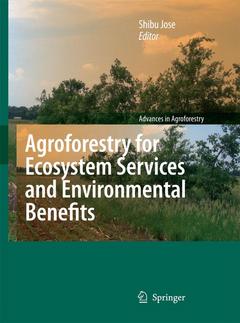Description
Agroforestry for Ecosystem Services and Environmental Benefits, 2009
Advances in Agroforestry Series, Vol. 7
Coordinator: Jose Shibu
Language: English
Subjects for Agroforestry for Ecosystem Services and Environmental...:
Publication date: 03-2012
264 p. · 21x27.9 cm · Paperback
Publication date: 10-2009
264 p. · 20.3x27.6 cm · Hardback
Description
/li>Contents
/li>Biography
/li>Comment
/li>
Agroforestry systems are believed to provide a number of ecosystem services; however, until recently evidence in the agroforestry literature supporting these perceived benefits has been lacking. This volume brings together a series of papers from around the globe to address recent findings on the ecosystem services and environmental benefits provided by agroforestry. Specifically, this volume examines four major ecosystem services and environmental benefits: (1) carbon sequestration, (2) biodiversity conservation, (3) soil enrichment and (4) air and water quality. Past and present evidence clearly indicates that agroforestry, as part of a multifunctional working landscape, can be a viable land-use option that, in addition to alleviating poverty, offers a number of ecosystem services and environmental benefits. This realization should help promote agroforestry and its role as an integral part of a multifunctional working landscape the world over. The book should be particularly useful to students, professionals, researchers and policy makers involved in natural resource management, agroforestry, biodiversity conservation, and environmental management.
Reprinted from Agroforestry Systems, Volume 76, No. 1 (2009)
Shibu Jose is Professor of Forest Ecology in the School of Forest Resources and Conservation at the University of Florida. He has authored more than 100 research articles that deal with ecological interactions, production ecology, and restoration ecology and edited four books. He currently serves as Editor-In-Chief of Agroforestry Systems, Book Review Editor of Forest Science, and Editorial Board Member of Research Letters in Ecology. He has also served as Editor of Journal of Forestry and Editorial Board Member of Tree Physiology in the past.
These books may interest you

Agroforestry and Ecosystem Services 158.24 €

Tropical Agroforestry 189.89 €

Tropical Agroforestry 137.14 €

